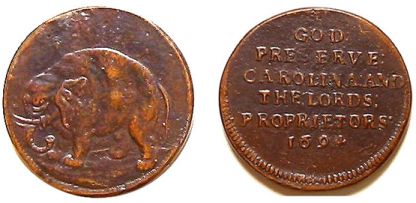
Elephant Tokens were unique circulating coins created in limited numbers in the early Carolina colony. In general, Carolina Elephant Tokens are more expertly crafted and heavier in composition than any of the standard merchant tokens issued by English tradesmen in the seventeenth century. Carolina pieces are also far more rare than the vast majority of tokens that survive from that era. Such characteristics imply that only small numbers of Carolina tokens were produced and that they were used for a special, perhaps singular purpose.
The Carolina Elephant Token's name, which dates from 1694, derives from the coin's most eye-catching design element: dominating its obverse (front) side is a full tusk-to-tail image of an elephant standing on a slightly textured plain. The animal is portrayed in left profile, with a slightly bowed head, its trunk tightly curling backward, and "an ear that in form resembles a withered tulip." Aside from this image, the only other decoration on original Carolina tokens is a simple, often off-center beaded border that garnishes the rim of their obverses and reverses. Although some specimens of the Carolina token and of other types of "elephant tokens" found their way to North America, likely nestled among the possessions of English immigrants, there is no evidence that the pieces were ever intended for widespread commercial use or employed on the continent for purchases of prescribed goods or services.
The year 1694 and a nearly identical seven-word inscription are struck in relief on the reverses of all Carolina Elephant Tokens: "God Preserve Carolina and the Lords Proprietors." The final word in this inscription at times appears spelled as "Proprieters." Historic studies have proposed that these tokens may have served foremost as promotional devices for drawing much-needed public attention and investments to the Lords Proprietors' struggling "American plantation." With regard to the tokens' production, their physical properties and circumstantial evidence indicate that they were struck during the latter half of 1694 at the Royal Mint, which operated behind the high stone walls of the Tower of London. Records show that during June and July in 1694 the Lords Proprietors held meetings in London on Tower Hill, only a short walking distance from the historic fortress. Since those meetings are the only documented times when the Proprietors convened in 1694, it is probable that arrangements for the token's production at the tower were finalized then and there.
Those who acquire Carolina tokens should take considerable caution, since many specimens thought to be original or marketed as genuine in the past have proven to be fakes. Since the 1860s, assorted reproductions of the token have been made, including struck copies, cast specimens, and high-quality electrotypes. There are electrotypes of the " PROPRIETOR" variety that have fooled both inexperienced and veteran collectors.